Exploring Culture
|| A number of different practices and activities helped me learn Spanish in this course. In TalkAbroad, I heard directly from a live, real Spanish speaker about life in their country (Peru). In “Texto” segments, I read in-depth accounts related to topics impacting contemporary Latin American society. In “Exploracion Cultural” segments, I learned details about day-to-day life in Spanish speaking countries.
|| Throughout all of the aforementioned activities, I learned specific details I was previously unaware of related to unit topics. Many of the things I learned caused me to re-evaluate the way I understood Latin America, Hispanic American culture, or contemporary issues. One activity that had particular resonance to me was the Unit 6 reading about LGBT families. I am a member of the LGBT community, and I found this resource about barriers to LGBT equality in Latin America to be invaluable. I also learned a lot about everyday life in Latin America from the short blurbs in the “Exploracion Cultural” segments. These were frequent and dense enough that by the last unit, I had learned a lot about everyday life: what college is like in different countries, what work culture is like, what gender dynamics are at play… Things like that really helped me resolve my preconceived notions about life in Latin America. Finally, TalkAbroads were invaluable to me, as unlike the theoretical interactions from much of the course work, I was able to actually ask questions about specific issues and details related to other countries. That sort of resource definitely better prepared me for speaking Spanish in the real world.
Engaging in Communities
|| Engaging in communities will always serve to broaden a person’s perspectives on the world. Engaging in your immediate community keeps you grounded, and helps you take pride in the people and places you interact with every day. Engaging in the global community allows someone to understand the perspectives of all sorts of people, and learn about things they’d never even thought of before.
Every unit included assignments related to cultural exploration, and I have completed all of them. They helped give perspective to much of the work.
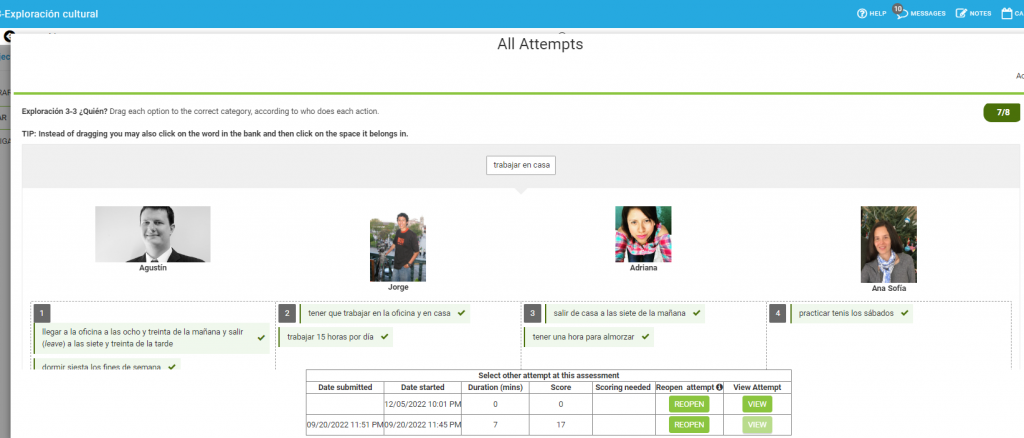
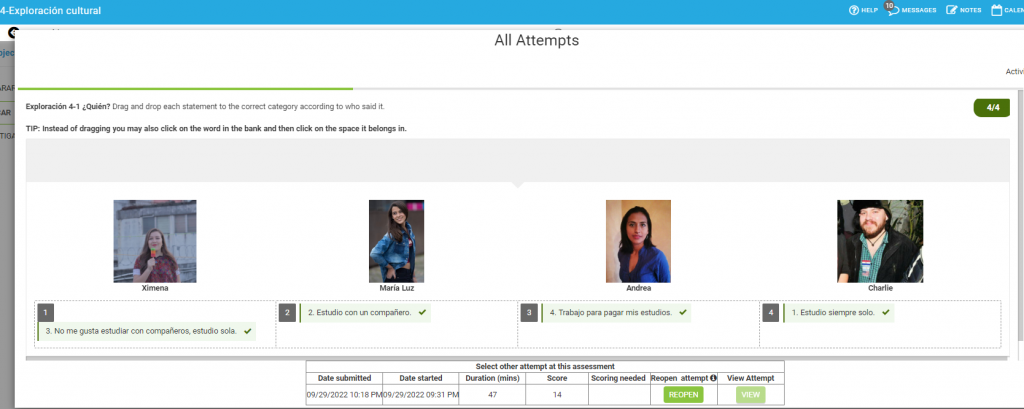
Additional artifacts on this subject can be found in the Interpersonal Communication tab, as I have completed 3 30 minute one-on-one conversations with a foreign Spanish speaker that relate to this topic.
|| When I was young, the only communities I interacted with were my local classmates; I interacted with my immediate community, but had no conception of or interest in the global community. When I went to school in the big city, though, I learned all about people from a number of countries and cultures, and made friends with several Spanish speakers who helped me understand the world. In this course, I strengthened this bond with the global community by reading and listening to a number of different people’s perspectives and life experiences. I learned a lot about daily life in Latin America, and I feel like I understand that part of the world much better now.
Interpersonal Communication
|| After every few units, I had a Talk Abroad assignment to complete. Each TalkAbroad assignment was a 30 minute conversation on selected topics related to previous units with a paid foreign national (with little or no English experience). I also had an “interview” style project earlier in the course, and every class included at least 15 minutes of Spanish language group work.
|| This segment of the class was by far the most difficult for me. I have naturally poor reaction and response times, and because of this even my English diction is halting and includes a number of pauses. However, just as I’ve learned to speak English regardless, so too have these activities helped me to learn Spanish. The hardest barrier within the conversations themselves was vocabulary recall; the worst performances of mine inside TalkAbroad are long pauses as I attempt to remember a specific word. However, I excelled at understanding my partner; there was never more than one or two words over an entire conversation I did not understand. I improved my performance by preparing more for spoken sections as well as practicing my vocabulary and preparing prefab questions before each conversation. Every TalkAbroad, I learned more about speaking Spanish and improved my diction and vocabulary.
|| In spontaneous, unplanned communication, I interacted with every student in class as well as the professor in Spanish for at least 30 minutes every class, and grew more familiar with spontaneous conversation as well. This was still difficult for me, but the informal setting reduced my stress a bit and made things easier to handle.
Presentational Speaking
|| This course contained several opportunities for presentational speaking. In one assignment, I composed a visual aid and an accompanying script (pre memorized) about life on the university campus. In another, I composed a more complex visual aid about a step-by-step process of making my favorite dish, then recorded and read a presentation about this topic to the class.
|| Presenting in front of the class was difficult for me, as a more solitary person, but it was good to gain some experience in this field. For both assignments, I had to memorize associated vocabulary, write a script which conformed to the standards set on the rubric, memorize said script, create a PowerPoint visual aid, and then record said visual aid alongside my reading presentation. These projects included elements from a number of mediums, making them daunting to compose. Next time, I would make a video of myself showing these things off as a visual aid rather than making a PowerPoint (both were acceptable options). I learned a lot about multimedia composition for these projects, and I’m glad that I had the opportunity to work on them.
Presentational Writing
|| In several units, I produced a number of written presentations on several different topics. In one unit, I produced a letter of recommendation for a person I admired (in this case, my older brother). In another unit, I produced an infographic on exercise.
The Letter of Reccomendation
“Hola,
Escribo esta carta porque yo conozco a una persona nominar para lo “Premio a la Mejor Persona”. La persona que yo quiero nominar para el premio es mi hermano, Yo sé que Lucas es inteligente, trabajador y fiel. Lucas estudia “los relacciones del mundo” en la universidad de George Mason. Adicionalmente, Lucas trabaja mucho en la organización de “NARLA” y el “ACLU”. Yo sé que Lucas trabaja muchas horas en su trabajo y en su universidad, Lucas es muy muy trabajador. Lucas tiene buenas notas también por lo tanto, Lucas es muy inteligente. Yo no conozco una persona más admirable como Lucas. Lucas merece lo “Premio a la Mejor Persona”.
Gracias por su tiempo.
Sinceramente, Caleb Summers”
The Infographic
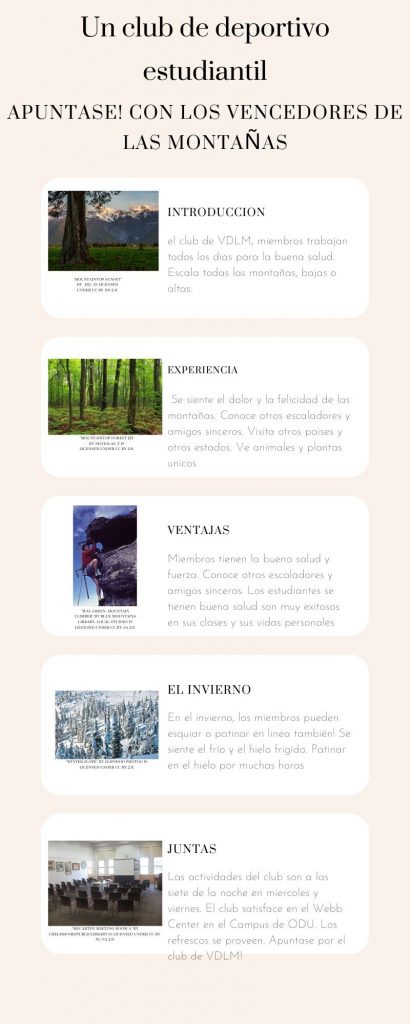
|| I learned quite a lot about written Spanish through these two assignments. The first project, “La Carta de Reccomendacion”, reinforced a number of skills present in writing formal Spanish. It also taught me conventions around discussing personal traits in the 3rd person and discussing admiration. The second project, “La Infografia” gave me experience with mixed media, as well as written Spanish in the command form. Making the infographic palatable while also preserving the meaning of the text was an additional challenge. I learned quite a bit through these written assignments.
Interpretive Listening
This course included frequent audio clips in Spanish related to whatever material was being explored in a particular unit. Nearly every homework assignment contained at least one of these resources. We also responded to each other’s work in comments after every spoken project.
Here is an example of one such Contraseña activity that involved determining the correct speaking style to refer to different people
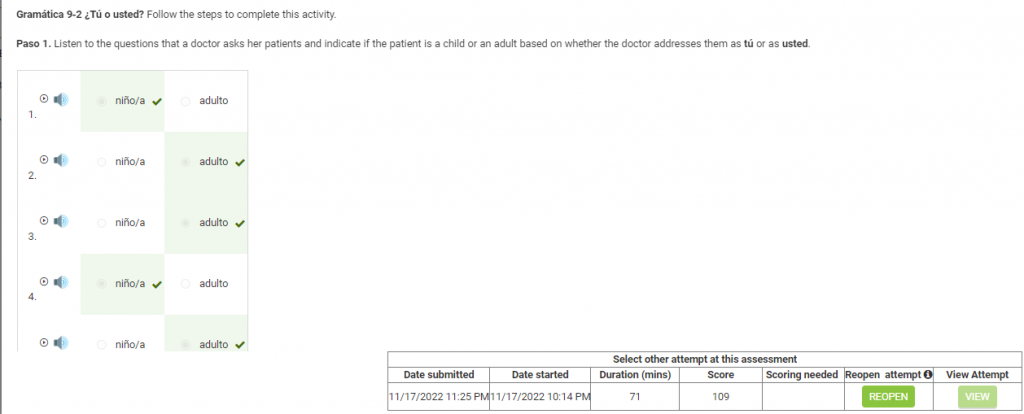
|| This area of the course is likely where I grew the most out of all areas. In the beginning, I understood Spanish but only at very slow speeds and in pre-prepared environments. Listening and interpreting a litany of Spanish language resources helped me so much in understanding spoken Spanish, as well as transcribing Spanish audio and answering questions surrounding it. I found mock conversations the most engaging, as they were usually about interesting topics and moved slower than some other material. I overcame my problems in this field through repetition and practice, and I feel it has payed off.
Interpretive Reading In this course, we read several long-form Spanish language articles and entries as a class. One article talked about the demographics and history of Latin America. Another article talked about gender, family, and LGBT issues in detail.
|| “El estatus de los derechos igualitarios es diferente de país a país. En algunos países como Argentina, Chile, Colombia, Ecuador y Uruguay el matrimonio igualitario es legal. En otros países, como Panamá, no hay matrimonio igualitario legal pero sí hay otros tipos de uniones legales entre personas del mismo sexo. En países como Bolivia, Cuba, Honduras y Paraguay el matrimonio igualitario está prohibido constitucionalmente. La lucha por este derecho continúa en muchos de estos países actualmente. Cuatro parejas cuentan cómo es la situación en sus países.
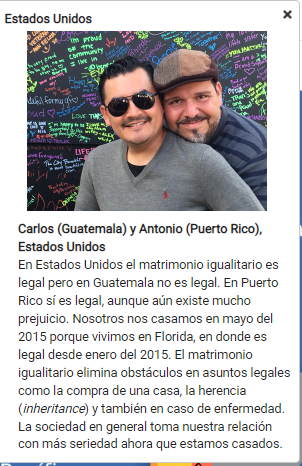
|| These activities were plentiful throughout several units, and always required a lot of focus to understand. The vocabulary involved was often relatively high-level, which made the assignment difficult, but exposed me to a lot of new words and phrases I had not seen before. The thing that was most interesting about these assignments, like the linked LGBT example, was the depth that these assignments explored their issues with. I learned specific dates and names attached to Latin American history, and specific legal barriers to marriage equality that exist today. I took away a lot of new information, even if it was a little sad. I’ve certainly grown my knowledge and vocabulary through these assignments.